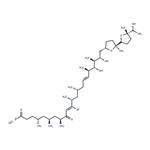Ionomycin is a calcium ionophore originally isolated from S. conglobatus. It induces intracellular calcium mobilization in X. laevis oocytes when used at a concentration of 5 μM. Ionomycin (5 μM) induces the formation of neutrophil extracellular traps (NETs) in isolated human neutrophils. Ionomycin in combination with phorbol 12-myristate 13-acetate (PMA; ) has commonly been used to induce the proliferation and activation of T cells, as well as to stimulate cytokine production in macrophages, in vitro.
Ionomycin is more effectivethan A23187 as a Ca++ionophore;
Ionomycin is used in research on Ca++ transport across biological membranes;
Ionomycin induces apoptotic degeneration of embryonic cortical neurons.
Ionomycin calcium salt is used as a polyether antibiotic and apoptotic degeneration inducer. Ionomycin induces apoptotic degeneration of embryonic cortical neurons and cell cycle arrest at G1 phase. It is more effective than A23187 (sc-3591) and provides a useful tool for increasing intracellular Ca2+ concentration.
Useful in cell activation experiments when calcium dose-response data are not required. Also available as a 10 mM solution in DMSO (Cat. No.
407953).
Calcium ionophore; more specific than A23187 (5-(Methylamino)-2-[[2R,3R,6S,8S,9R,11R)-3,9,11-trimethyl-8-[(1S)-1-methyl-2-oxo-2-(1H-pyrrol-2-yl)-ethyl]-1,7-dioxaspiro[5.5]undec-2-yl]methyl]-4-benzoxazolecarboxylic acid ).
Product does not compete with ATP.
Liu et al. (1978), Ionomycin, a new polyether antibiotic; J. Antibiot., 31 815
Liu and Hermann et al. (1978), Characterization of ionomycin as a calcium ionophore; J. Biol.Chem, 253 5892


